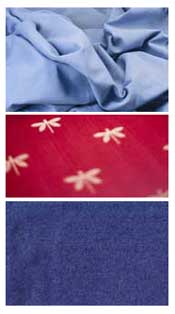
Cotton fabrics, as they come from the loom in their rough, unfinished stages, are known as greige goods. Most undergo various finishing processes to meet specific end-use requirements.
Some mills, in addition to spinning and weaving, also dye or print their fabrics and finish them. Others sell greige goods to converters who have the cloth finished in independent plants.
 Finishing processes are numerous and complex, reflecting today’s tremendous range and combination of colors, textures and special qualities.
Finishing processes are numerous and complex, reflecting today’s tremendous range and combination of colors, textures and special qualities.
In its simplest form, finishing includes cleaning and preparing the cloth, dyeing or printing it and then treating it to enhance performance characteristics.
To produce a smooth surface in preparation for dyeing and finishing, the greige goods are passed rapidly over gas-fired jets or heated copper plates to singe off lint and loose threads.
Moving at speeds that can be greater than 200 yards a minute, the material is scoured and bleached in a continuous process that involves the use of hydrogen peroxide. The time for the chemicals to do the preparation reactions occurs from piling the fabric on conveyor belts that pass through steaming chambers, or stacking in large steam-heated, J-shaped boxes before the goods are withdrawn from the bottom.
If a more lustrous cloth is desired, the goods are immersed under tension in a caustic soda solution and then later neutralized. The process, called mercerizing, causes the fiber to swell permanently. This gives the fabric a silken sheen, improves its strength and increases its affinity for dye. Mercerizing also can be done at the yarn stage.

